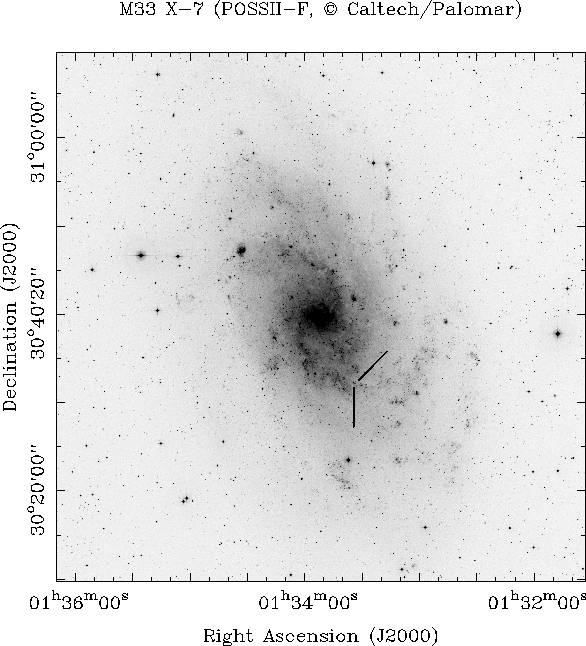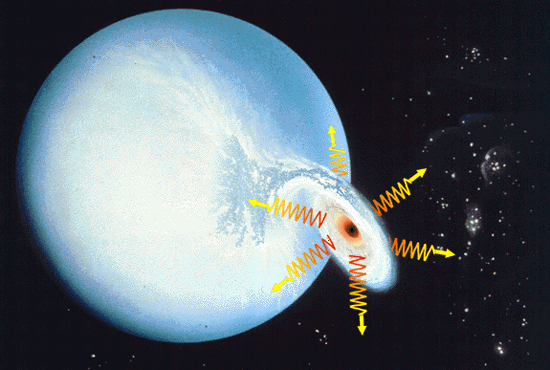
Finding chart for M33 X-7 (image from the ESO Online Digitized Sky Survey)
Recent X-ray observations using NASA's Chandra X-ray Observatory have revealed a remarkable X-ray source that is periodically eclipsed every 3.5 days by its companion star. The X-ray source is located in the spiral galaxy M33 at a distance of 2.6 million light years in the constellation of Triangulum. Eclipsing binaries are relatively rare because they require that the system be observed nearly edge-on, and there are only a few such systems known that contain a strong X-ray source. This eclipsing X-ray source, which was dubbed "M33 X-7," is the only one thought to contain a black hole (the others contain neutron stars).
I am the leader of an international team that obtained optical observations of M33 X-7 using the 8.2 meter Gemini North telescope, which is located on the Island of Hawaii. In total, we obtained several dozen spectral and imaging observations during the fall of last year. The Doppler velocities of the companion star, which are inferred from the spectra, show that its orbital velocity in the line-of-sight exceeds 110 km/sec (for comparison, the Earth's orbital speed is 32 km/sec). A detailed analysis of all of the data yields mass estimates for the X-ray source and companion star of 14 and 60 times the mass of the Sun, respectively. Our determination of M33 X-7's large mass establishes that the X-ray source is a black hole, since the mass of any other collapsed object, such as a neutron or quark star, cannot exceed about 3 Sun masses.
The confirmation of the presence of a black hole in M33 X-7 is exciting for a number of reasons. This is the only known eclipsing binary that contains a black hole, and the presence of eclipses opens up new possibilities for exploring the properties of black holes. Furthermore, this is one of the most massive black-hole remnants of stellar collapse that have been discovered to date. In addition, the companion star in M33 X-7 is the most massive companion star in an X-ray binary, making this system central to the study of the evolution of X-ray binaries and of massive stars themselves. It is also notable that the determination of a precise mass for M33 X-7 at a distance that is 100 times that of Milky-Way black holes marks a breakthrough in observational capability. Finally, with the distance to the source and the mass of the black hole known, and using the exquisite Chandra X-ray data, my collaborators and I are in the process of measuring the spin of this black hole. Since a black hole is completely defined by just two numbers that specify its mass and spin (we know of nothing else this simple except for an electron or a quark!), the measurement of M33 X-7's spin will provide us with a complete description of this distant black hole. in extreme conditions.

Finding chart for M33 X-7 (image from the
ESO Online Digitized Sky Survey)

An artist's sketch of M33 X-7 (image
source)
Click here for an article about X-ray observations of black holes in the most recent Chandra Observatory Newsletter.